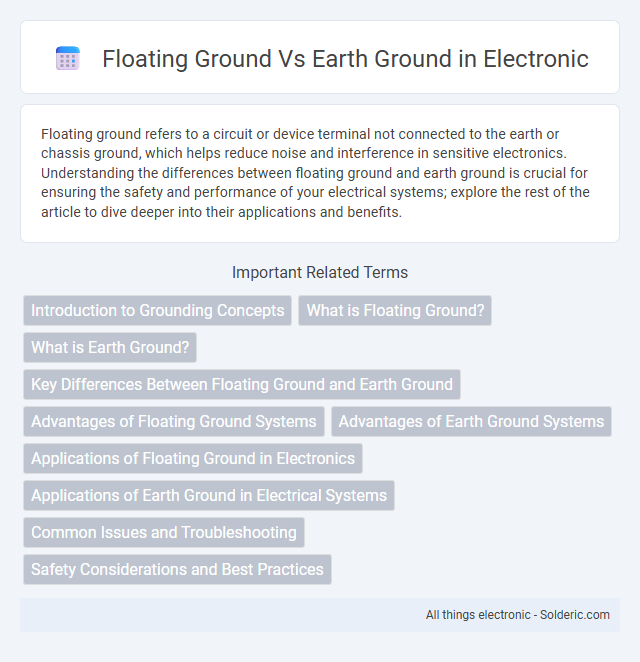Floating ground refers to a circuit or device terminal not connected to the earth or chassis ground, which helps reduce noise and interference in sensitive electronics. Understanding the differences between floating ground and earth ground is crucial for ensuring the safety and performance of your electrical systems; explore the rest of the article to dive deeper into their applications and benefits.
Comparison Table
| Aspect | Floating Ground | Earth Ground |
|---|---|---|
| Definition | Ground reference not connected to Earth; isolated from Earth potential. | Ground reference connected directly to the Earth for safety and stability. |
| Connection | Isolated circuit ground; no direct Earth connection. | Directly bonded to Earth through grounding electrode. |
| Application | Used in sensitive electronics to reduce noise and ground loops. | Used in building wiring and electrical safety systems. |
| Safety | May present shock hazard without proper isolation. | Provides safety by dissipating fault currents into Earth. |
| Noise Immunity | Improves noise immunity in sensitive circuits. | Can introduce ground loop noise if not properly designed. |
| Common Use Cases | Battery-powered devices, isolated measurement instruments. | Electrical installations, lightning protection, grounding grids. |
Introduction to Grounding Concepts
Floating ground and earth ground represent two fundamental grounding concepts essential for electrical safety and signal integrity. Floating ground refers to a system or circuit that is not connected directly to the earth, which reduces risk of ground loops and noise interference in sensitive electronic equipment. Understanding these distinctions helps you ensure optimal grounding practices in your electrical and electronic applications, enhancing performance and safety.
What is Floating Ground?
A floating ground refers to an electrical node or reference point that is not physically connected to the earth or chassis ground, resulting in a potential difference relative to Earth ground. It is commonly used in isolated circuits and sensitive measurement equipment to prevent ground loops and reduce noise interference. Floating grounds enhance safety and signal integrity by maintaining isolation from external electrical disturbances.
What is Earth Ground?
Earth ground refers to a safety connection in electrical systems where conductive parts are physically connected to the earth, providing a path for fault currents to dissipate safely into the ground. This grounding minimizes electric shock hazards and protects equipment from voltage surges by stabilizing voltage levels. Earth ground typically involves grounding rods or plates driven into the soil, ensuring a low-resistance path to the earth.
Key Differences Between Floating Ground and Earth Ground
Floating ground refers to a reference point in an electrical circuit that is not connected to the physical Earth, often isolated to prevent interference or ground loops. Earth ground is a direct connection to the Earth's conductive surface, providing a low-resistance path to safely dissipate electrical faults and static charges. Your choice between floating ground and earth ground depends on the application's need for noise reduction or safety grounding.
Advantages of Floating Ground Systems
Floating ground systems offer enhanced safety by isolating sensitive electronics from electrical noise and potential ground faults, reducing the risk of interference and damage. They improve signal integrity in measurement and communication applications by minimizing ground loops and electromagnetic interference. Your equipment benefits from more stable operation and increased protection in environments where earth ground connections are unreliable or noisy.
Advantages of Earth Ground Systems
Earth ground systems offer superior safety by providing a low-resistance path for fault currents, minimizing electric shock hazards. They enhance electrical system stability and noise reduction, improving the performance and reliability of sensitive equipment. Proper earth grounding also ensures compliance with electrical codes and standards, preventing damage from lightning and transient electrical surges.
Applications of Floating Ground in Electronics
Floating ground is commonly used in sensitive electronic applications like audio equipment and medical devices where isolation from earth ground prevents noise and interference. It enhances signal integrity in precision measurement instruments by reducing ground loops and electromagnetic interference. Ensuring your design leverages floating ground can improve performance in environments with multiple grounding points.
Applications of Earth Ground in Electrical Systems
Earth ground in electrical systems ensures safety by providing a direct path for fault currents, preventing electric shock and equipment damage. It stabilizes voltage levels, reduces electromagnetic interference, and improves the reliability of power distribution networks. Common applications include grounding of electrical panels, lightning protection systems, and transient voltage suppression devices.
Common Issues and Troubleshooting
Floating ground circuits often cause measurement errors and noise interference due to the lack of a direct reference to earth ground, which can result in unpredictable voltage levels. Common troubleshooting steps include verifying ground connections with a multimeter and ensuring proper grounding to reduce electromagnetic interference and signal distortion. Your equipment's performance improves significantly by addressing floating ground issues, typically through adding or securing earth ground connections.
Safety Considerations and Best Practices
Floating ground systems reduce the risk of electric shock by isolating circuits from earth potential, minimizing current flow during faults. Earth ground provides a direct path to dissipate fault currents safely into the soil, enhancing protection against electrical hazards. Best practices include ensuring proper grounding connections, using insulating barriers for floating grounds, and regularly testing continuity to maintain effective safety.
Floating Ground vs Earth Ground Infographic

 solderic.com
solderic.com